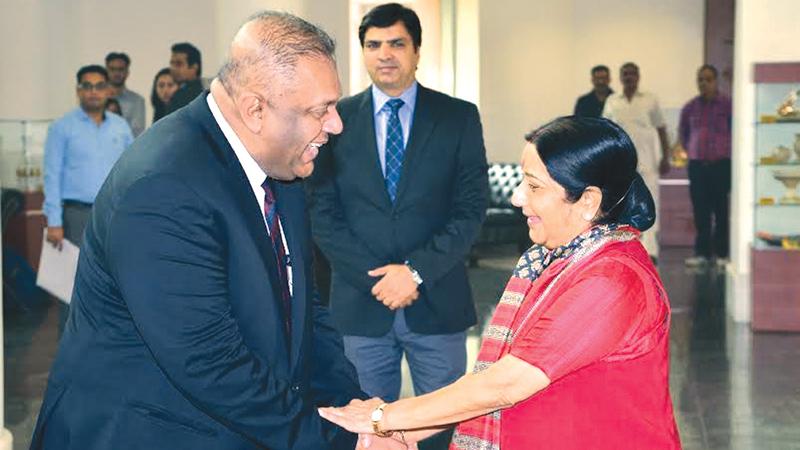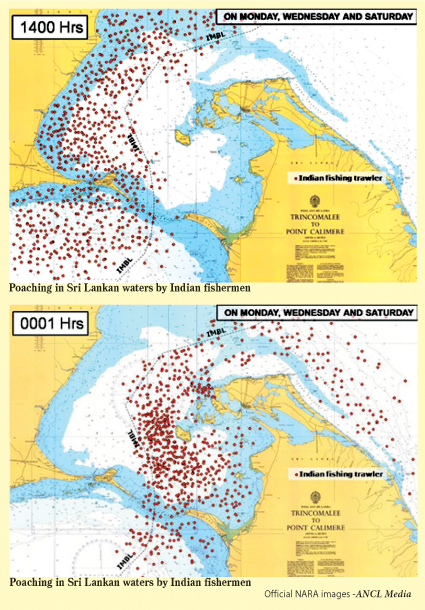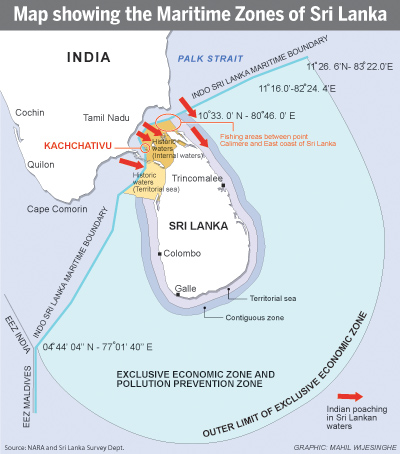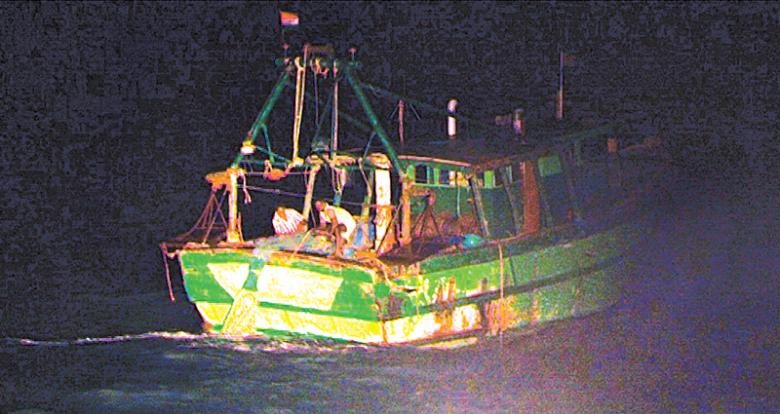
Sri Lanka and India took a major step forward last week, to resolve the decade-old Palk Bay fishing dispute, at bi-lateral level, reaching consensus on a number of contentious issues, including the practice of bottom trawling by Indian fishermen.
This was amid some Members of the Opposition professing, ‘the matter would never be resolved unless it is internationalized’, meaning, it should be raised before the International Tribunal for the Law of the Sea.
 The acute debate over the Indian trawlers’ infiltration into Sri Lankan territorial waters to engage in illegal and destructive fishing has dominated the post LTTE northern politics, just as strong as the ongoing reconciliation process.
The acute debate over the Indian trawlers’ infiltration into Sri Lankan territorial waters to engage in illegal and destructive fishing has dominated the post LTTE northern politics, just as strong as the ongoing reconciliation process.
On October 9, 2015 the Government and Opposition Parliamentarians collectively condemned poaching by Indian boats, depriving the Northern fisherfolk, waiting for a new lease of life after the war. For once, everyone present in the House, in unison, called for speedy action. It was not the first instance that this debate has .overshadowed Parliament proceedings of the two neighbours. Even though Tamil Nadu was peddling a political agenda the Centre always upheld the notion that the intrusion of Indian vessels into its small neighbour’s territory must end.
At the discussions between the two Foreign Ministers and Fisheries Ministers, previous Saturday, India agreed for the first time in principle, that bottom trawling should be banned in their country. It was among several other proposals aimed at ending the issue.
“We believe our intense briefing based on hard facts, helped change the perspective of the Indian side who were primarily asking for the release of the vessels in Sri Lankan custody, and for a phase out period to gradually end the Indian vessels from breaching our territorial waters,” Fisheries and Aquatic Resources Minister Mahinda Amaraweera said.
He said, the talks ended on a positive note although the Sri Lankan side led by Foreign Minister Mangala Samaraweera was not submissive to the Indian demands.
“It was clear that the Indian Government was cordial and ready to work with us on this issue. And they were all ears to what we had to say,” he said.
At the meeting, they had discussed the need to find alternative livelihoods for Indian fishermen, who might lose jobs as a result of measures that are in the offing. The Indian delegates have agreed to make budgetary allocations to ensure a gradual transition of fisherfolk from seafaring to other sectors. Chief among the proposals was the setting up of a Joint Working Group on Fisheries to facilitate a regular dialogue among the fishermen, officials and the Navy. They have also agreed to joint patrols by the two Navies which was another breakthrough.
However, an opinion carried in India’s respected, The Hindu, on Monday cautioned, “An agreement on this is crucial, but in the absence of a time frame there remains a question mark over a solution emerging”.
A reader at the bottom of the ‘opinion’ penned: “Fishermen should go for alternative profession. Their life is an endless struggle. They are exploited a lot by the cartel of middlemen and exporters. This is the stark reality. The boats cannot be stopped unless the Governments offer them alternative means of subsistence. The Indian trawlers are owned by wealthy businessmen cum politicians or film personalities in South India, from Tamil Nadu in particular; but the men or boys who work in these boats take up to this living due to poverty. In contrast, Sri Lankan boats are mostly owned by small time fishermen.”
Minister Amaraweera said, the Joint Working Group on Fisheries will meet every three months to evolve a blueprint of action aimed at finding a viable solution for this age old issue, born out of Indians’ claim for access to their historical fishing grounds and resting point near Katchchethivu.
However, this claim had been disputed. “If it is the case, there should be a concentration of about a hundred boats near the islet, but we have observed Indian trawlers as far as 30 kilometres off Katchchathivu, spreading towards KKS, south of Point Pedro and even near Guru Nagar Lagoon,” official sources said.
“Ïf Katchchathivu is the case we could make a passage way for them to get to the islet. That can be resolved easily,” he said.
The Indian trawlers spread across the sea from Puttalam to Mullaitivu and due to their bottom trawling, perhaps the only fishing method these boatmen are conversant with, the entire marine life and eco systems are being disrupted and destroyed, turning the area into a dead sea, NARA has cautioned. The Government imposed a strict ban on illegal fishing practices by the Sri Lankan fishermen and has begun raids to apprehend the offenders, even at the point of fish markets.
The Sri Lankan side at Saturday’s meeting had been adamant that the practice of Indian trawlers breaching its maritime border should cease, while also rejecting a proposal to have a grace period of three years for Indian vessels to fish in the Sri Lankan side of the International Maritime Boundary Line (IMBL). They proposed to open borders for 85 days per year (approximately two days a week). At the end of the three years they have vowed to stop the vessels from poaching on this side of the Palk Bay. “We will continue to apprehend the boats crossing the maritime border. The practice of detaining the fishing vessels and their fishing gear too will be continued,” the Minister stressed.
 He said, the practice by the Navy has proved to be effective in discouraging the Indian boats from poaching. “The boat hands are poor, day workers. Their arrests have little impact on poaching, but detaining the boats did make a difference shown by a significant decline in their arrival.”
He said, the practice by the Navy has proved to be effective in discouraging the Indian boats from poaching. “The boat hands are poor, day workers. Their arrests have little impact on poaching, but detaining the boats did make a difference shown by a significant decline in their arrival.”
There are 114 Indian fishing vessels currently in the custody of the Lankan authorities. Sri Lanka is expected to bring in amendments to its laws soon to release the fishermen the same day the Navy intercepts the boats. “We don’t want to detain the men even for a single day,” the Minister said. At present, the poachers are handed over to the police by the Navy to be produced before a court of law, prior to their release.
According to a recent NARA report, Indian vessels enter the Lankan territorial waters three days a week (Monday, Wednesday, Saturday) at the dead of night. Nearly, 1,000 such vessels breach the maritime boundary a day. Their daily catch comes close to 600 metric tonnes, which is nearly 32,000 metric tonnes of fish harvest a year. The annual loss to the island caused by these poachers is estimated to be around US$ 40-60 million. There is a lull in their poaching for about seven weeks from April to May, during the breeding season.
According to a report, the Navy counted 130,000 boats poaching in Sri Lankan waters during the past three years. They have arrived 140 days a year during this period.
Saturday’s meeting was also attended by representatives of the fishing community from both sides. There was another difference. For the first time, a TNA Member of Parliament, M.A. Sumanthiran was allowed to take part in these crucial talks to resolve the fishing dispute that concerns mostly the Northern Tamil community.
Mannar District Fishermen’s Cooperative Society Union President, Noor Mohamed Aalam said, a similar phasing out period for one year was set by the Fishermen’s Associations of both countries in 2010, but without success. “This arrangement did not have the blessings of the two governments. The dispute is between the fishermen, therefore we could have implemented the agreement on our own,” he explained, pointing out the futility of such strategies in the future.
Aalam who was part of the delegation that took part in the recent Delhi meeting said, he was happy the way the Sri Lankan Ministers presented the case of the local fishermen. “We cannot allow them to enter our waters for even a day and rob our fishing bank. Besides, their practice is not going to stop at the end of the three years.”
The local fishermen have little say when the bigger Indian vessels made of steel, storm into their territory, nearly capsizing their smaller vessels made of fibre-glass.
Their trawlers move in the dark, to avoid being spotted by the SL Navy, rip and destroy their fishing nets, which have cost them an arm and a leg to acquire.
Before 2009, the Sri Lankan fishermen, restricted by the terrorist activities, were sandwiched between the LTTE and the Government Forces. There was a blanket fishing ban imposed by the Navy up to 2-3 nautical miles in the northern sea, until the end of the war. Lifting of the fishing ban, took sometime due to a bureaucratic tug of war.
The Indian Fisheries Minister is expected in Sri Lanka on January 1 to take part in the first Ministerial level meetings on the issue. The fishermen of both sides of the divide are hopeful the talks under the Joint Working Group will this time bear tangible results, depriving none and holding no one to ransom.

An Indian trawler in Sri Lankan territorial waters under surveillance by Fisheries Minister Mahinda Amaraweera

A close-up of an Indian trawler
